Trace in cold process soapmaking is the moment when your oils and lye solution begin to emulsify, signaling the start of saponification. You'll recognize it when your mixture thickens enough to leave a visible trail across the surface. Trace can range from light (like thin pancake batter) to thick (like pudding). Factors like temperature, oil types, and mixing methods all affect how quickly your soap reaches trace. Understanding these stages helps you control your soap's final texture and design complexity.
7 Second-Level Headings for "What Is Trace When Making Cold Process Soap?"
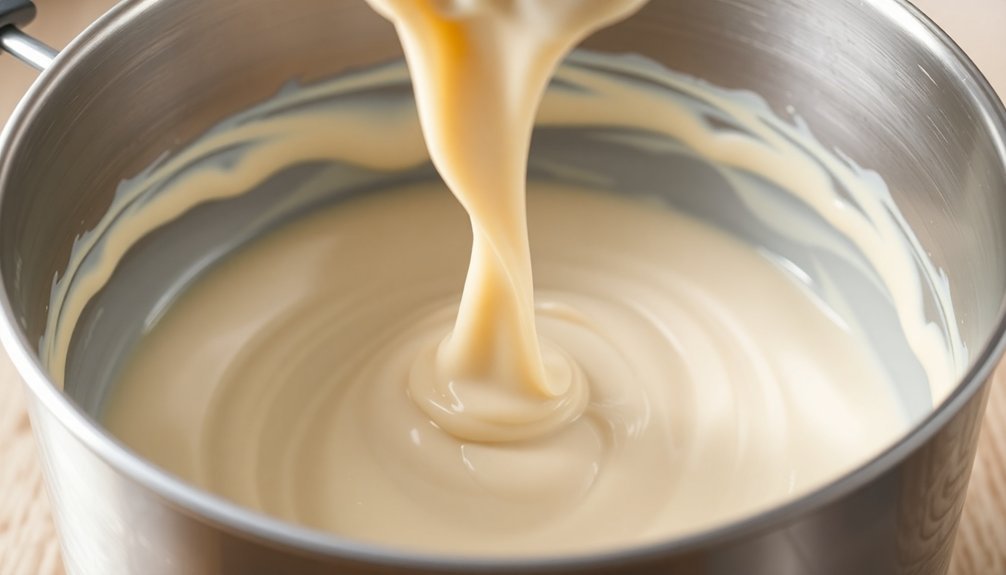
In order to understand trace in cold process soapmaking, you'll need to grasp several key concepts that build upon each other.
Let's break down the essential headings that would structure your knowledge:
First, "What Is Trace?" explains the moment when oils and lye become emulsified, signaling the beginning of saponification.
Next, "Stages of Trace" covers the progression from light trace (thin batter consistency) to thick trace (pudding-like texture).
"Factors Affecting Trace Speed" examines how temperatures, oil types, and additives influence how quickly your soap reaches trace.
"Recognizing False Trace" helps you identify when your mixture appears thickened but isn't properly emulsified.
Finally, "Working with Different Trace Levels" teaches you which trace consistency works best for various soap making processes and design techniques.
Defining Trace: The Science of Soap Emulsification
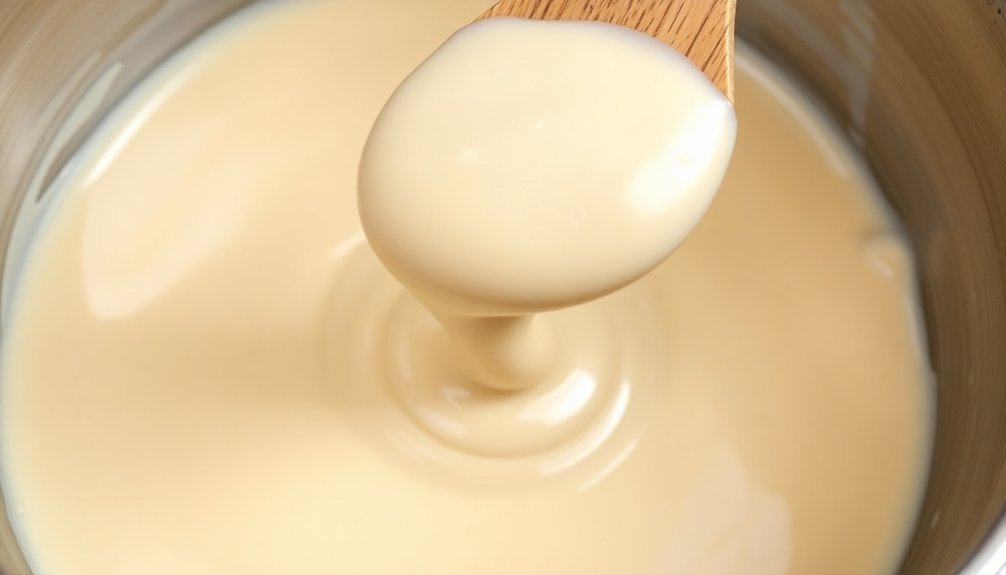
Three chemical forces converge when you reach trace in cold process soapmaking: emulsification, saponification, and suspension. When oils and lye meet, they initially resist mixing. True trace occurs when these ingredients emulsify, marking the beginning of the saponification process. The soap mixture thickens markedly, leaving a visible trail when drizzled.
| Trace Stage | Appearance | Best Uses |
|---|---|---|
| Light trace | Thin, liquid | Colorants, scents |
| Medium trace | Pudding-like | Swirls, layers |
| Thick trace | Frosting-like | Textured tops |
Temperature notably impacts how quickly you'll reach trace—warmer ingredients accelerate emulsification. Don't confuse false trace (a grainy, separated mixture caused by cool temperatures) with true trace. Proper trace feels smooth and uniform, indicating your soap is properly emulsified and saponification is underway.
Recognizing Different Stages of Trace: From Ultra-Light to Thick
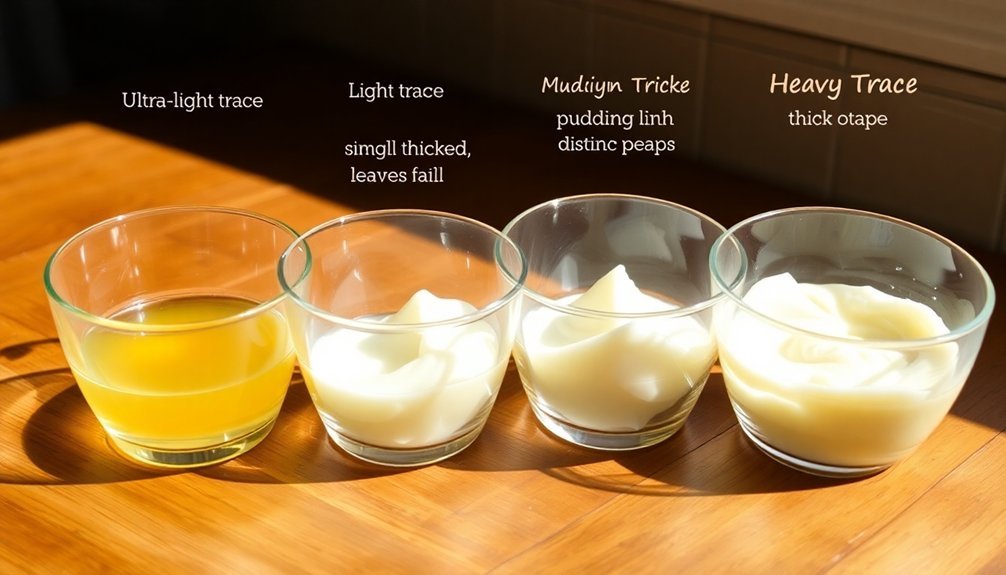
The journey from raw ingredients to finished soap passes through distinct trace stages, each offering unique opportunities for creativity and technique.
As you blend oils and lye, the chemical reaction transforms your soap batter through increasingly thicker consistencies.
- Ultra-Light Trace: Resembles cream with no visible trails—perfect for complex designs requiring maximum working time
- Light Trace: Shows visible lines when drizzled (like thin cake batter)—ideal time to add colorants and fragrances
- Medium Trace: Thickens to thin pudding consistency with distinct trailings—supports heavier additives and embeds
- Thick Trace: Holds its shape for sculpting and detailed layering—best for experienced soapmakers
Watch carefully for false trace, which appears when soap batter thickens without being properly emulsified—it looks grainy and occurs at cooler temperatures, requiring additional mixing to achieve true trace.
Common Factors That Affect Trace Speed
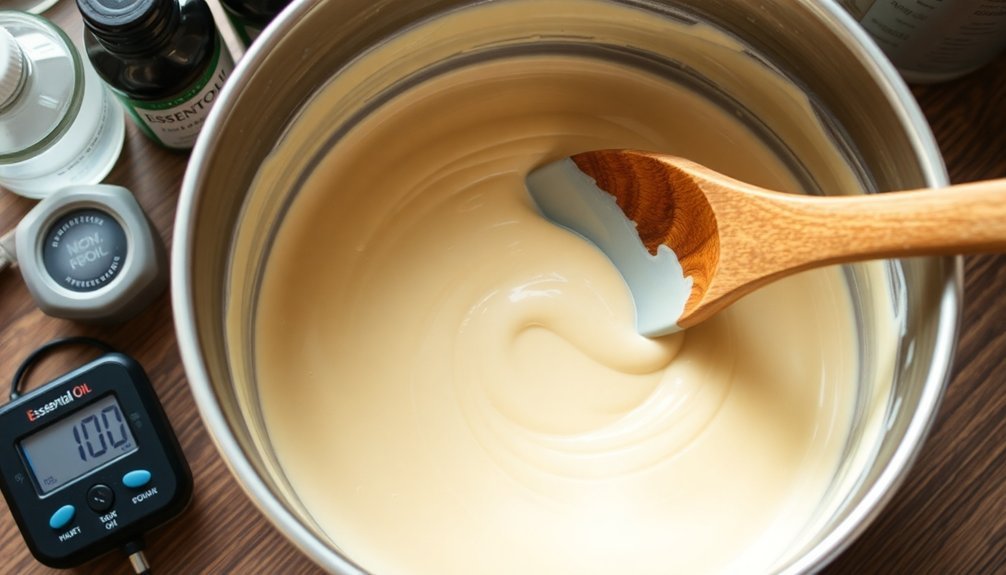
While mastering cold process soapmaking requires practice, understanding what influences trace speed gives you greater control over your creations.
Temperature plays an essential role—warmer lye and oils accelerate trace, while cooler ingredients slow it down. Your choice of fats matters greatly; solid oils rich in saturated fatty acids trace faster than liquid oils with unsaturated fatty acids.
Your mixing method dramatically impacts timing—a stick blender achieves trace in minutes compared to hand stirring's longer process.
Many fragrance oils, especially floral and spicy varieties, can accelerate trace, while citrus scents typically don't.
Finally, consider adjusting your water content; implementing a water discount results in quicker trace and firmer bars that require less curing time.
Temperature Management for Optimal Trace Control
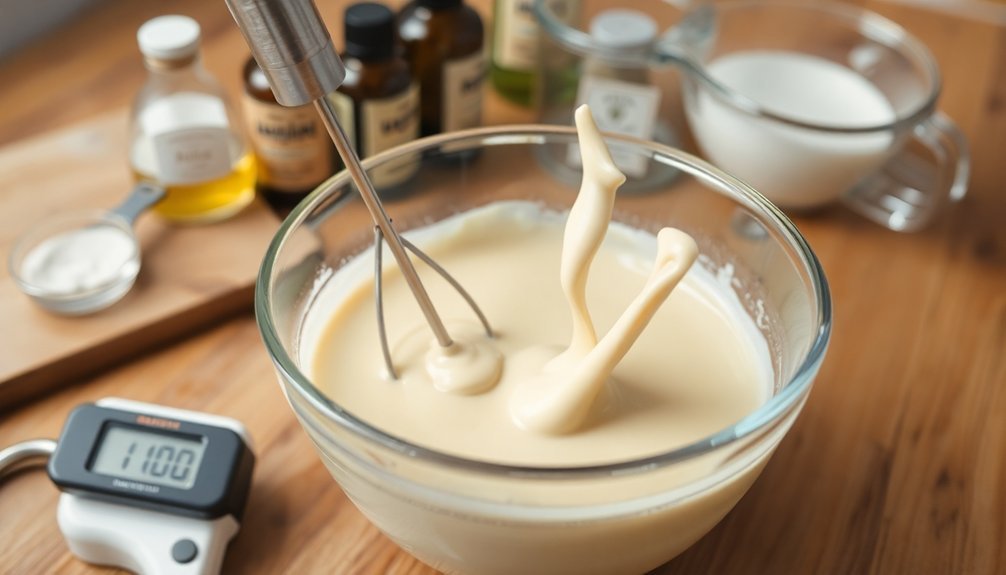
Achieving consistent, predictable results in cold process soapmaking depends greatly on your temperature management skills.
When you monitor temperatures accurately, you'll gain control over the trace development process, avoiding unwanted acceleration or false trace issues.
- Maintain temperatures between 90-110°F for balanced saponification—higher temperatures accelerate trace, while lower ones may cause false trace.
- Consider cooling your lye solution before mixing with oils to extend your working time for complex designs.
- Use an infrared thermometer for accurate monitoring, ensuring both components stay within ideal ranges.
- Adjust your water discount thoughtfully—higher discounts (25-33%) create faster trace but may affect the gel phase.
Temperature management isn't just about preventing problems—it's about deliberately controlling your recipe's behavior to achieve your desired soapmaking results.
Essential Oils and Fragrance Impacts on Trace Development
Essential oils and fragrance oils can greatly impact how quickly your soap reaches trace, with some accelerating the process while others slow it down.
You'll find lavender and citrus oils typically extend your working time, whereas florals like ylang ylang and spices such as cinnamon rapidly speed up trace.
Before adding any fragrance to your full batch, it's worth testing it in a small sample to understand its unique behavior and adjust your process accordingly.
Subheading Discussion Points
The careful selection of fragrances can dramatically influence your soap's trace development time. When you're planning intricate designs, you'll want additives that give you more working time before your soap becomes fully emulsified.
- Lavender and citrus essential oils typically slow down trace, extending your window for creating complex patterns.
- Floral and spicy oils like Ylang Ylang, Geranium, and Cinnamon tend to accelerate trace considerably.
- Fragrance oils vary widely—floral scents often speed up trace, while cologne-type fragrances can cause rapid thickening or even seizing.
- Always test new fragrances in small batches before committing to a full recipe.
For best results, mix your colors into the soap before adding fragrance. This prevents premature acceleration and keeps your design options open throughout the soapmaking process.
Acceleration vs. Deceleration Properties
When selecting additives for your cold process soap, you'll quickly discover that fragrances and essential oils don't just contribute scent—they actively influence how quickly your soap reaches trace.
Lavender and citrus essential oils typically decelerate trace, giving you extra time for intricate design work. Conversely, floral and spicy oils like Ylang Ylang and Cinnamon accelerate the process, causing faster thickening of your soap batter.
Fragrance oils vary widely—floral scents like Rose often speed up trace, while cologne-based fragrances can cause rapid acceleration.
Always add colorants before fragrances to better manage the trace process and prevent premature thickening.
For best results, conduct testing with small batches, as some oils behave unpredictably. Consulting supplier information about specific acceleration properties can save you from design disasters and guarantee smooth soap making.
Testing Fragrance Beforehand
Why risk ruining an entire batch of soap when you can test your fragrances first? Different oils impact trace development uniquely during the soap making process, affecting your working time for intricate designs. Testing fragrance oils in small batches reveals their behavior before committing to larger projects.
- Essential oils like Lavender and Citrus tend to slow down trace, giving you more time for complex designs requiring working time.
- Floral and spicy oils such as Ylang Ylang, Geranium, and Cinnamon typically accelerate trace, limiting your creative window.
- Always mix colors before incorporating fragrance to prevent premature thickening.
- Consider consulting supplier information about specific fragrance oils to better plan your formulation.
This proactive approach saves materials and frustration while ensuring your creative vision comes to life.
Troubleshooting False Trace and Seizing Issues
Even experienced soap makers occasionally encounter false trace or seizing, two common issues that can derail your cold process soap batch.
False trace appears grainy or thick but lacks proper emulsification, often resulting from cool temperatures where solid oils solidify before fully saponifying. To identify it, look closely at your soap batter—proper trace should be smooth and consistent, while false trace shows an uneven surface or separation.
If you suspect false trace, try gently stirring to promote emulsification.
For seizing issues, where your mixture thickens too quickly due to high temperatures or reactive fragrances, prevention is key. Maintain ideal temperatures for both your lye solution and oils (below 110°F) to guarantee better control over the process.
This temperature management helps prevent both problems, giving you more working time with your soap.
Frequently Asked Questions
What Is Trace in Cold Process Soap?
Trace is when your oils and lye water have emulsified during cold process soapmaking. You'll notice it's reached trace when the mixture thickens, resembling thin to thick pudding, allowing you to add colorants and fragrances.
What Causes False Traces in Soap Making?
False trace happens when your soap mixture thickens prematurely due to cool temperatures solidifying oils rather than true saponification. You'll notice a grainy texture with possible oil separation instead of the smooth, stable emulsion of genuine trace.
What Is a Soap Tracer?
A soap tracer is your tool for checking when your soap mixture has reached trace. You'll use it to drizzle soap across the surface, revealing whether saponification has begun by the pattern it leaves behind.
What Does a False Trace Look Like in Soap?
A false trace looks grainy rather than smooth, with premature thickening and visible oil streaks. You'll notice it doesn't hold shape well when you stir it. It's often caused by cool temperatures affecting your soap batter.
In Summary
Understanding trace is essential to your soap making success. You'll gain confidence as you recognize its different stages and learn to control it with temperature management and careful additive selection. Whether you're aiming for intricate designs or simple bars, mastering trace timing gives you the power to create exactly what you want. Remember, practice makes perfect—each batch teaches you something valuable about this critical soap making milestone.

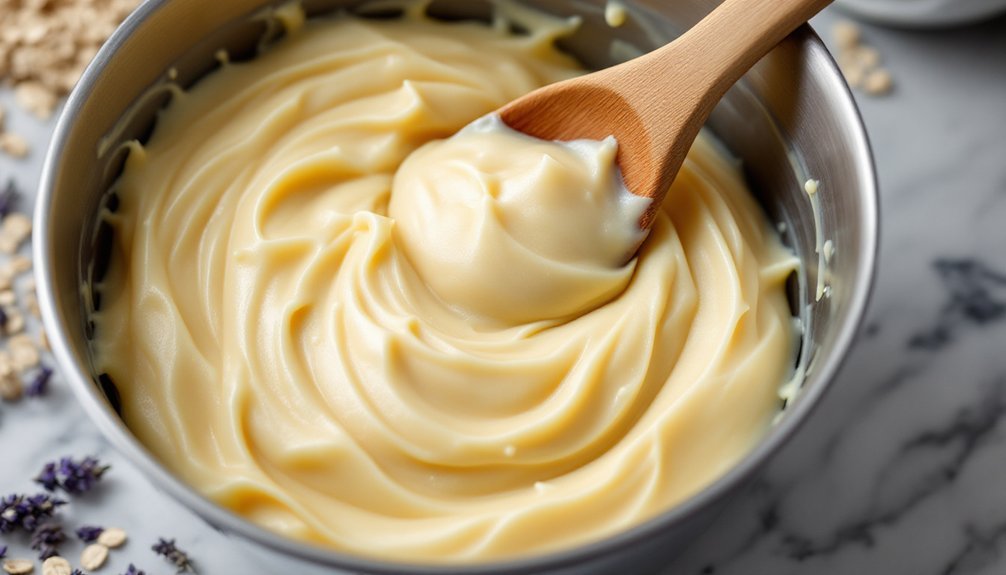



Leave a Reply